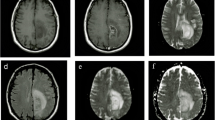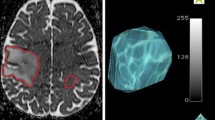Abstract
The aim of this study was to design a predictive radiobiological model of normal brain tissue in low-grade glioma following radiotherapy based on imaging and molecular biomarkers. Fifteen patients with primary brain tumors prospectively participated in this study and underwent radiation therapy. Magnetic resonance imaging (MRI) was obtained from the patients, including T1- and T2-weighted imaging and diffusion tensor imaging (DTI), and a generalized equivalent dose (gEUD) was calculated. The radiobiological model of the normal tissue complication probability (NTCP) was performed using the variables gEUD; axial diffusivity (AD) and radial diffusivity (RD) of the corpus callosum; and serum protein S100B by univariate and multivariate logistic regression XLIIIrd Sir Peter Freyer Memorial Lecture and Surgical Symposium (2018). Changes in AD, RD, and S100B from baseline up to the 6 months after treatment had an increasing trend and were significant in some time points (P-value < 0.05). The model resulting from RD changes in the 6 months after treatment was significantly more predictable of necrosis than other univariate models. The bivariate model combining RD changes in Gy40 dose-volume and gEUD, as well as the trivariate model obtained using gEUD, RD, and S100B, had a higher predictive value among multivariate models at the sixth month of the treatment. Changes in RD diffusion indices and in serum protein S100B value were used in the early-delayed stage as reliable biomarkers for predicting late-delayed damage (necrosis) caused by radiation in the corpus callosum. Current findings could pave the way for intervention therapies to delay the severity of damage to white matter structures, minimize cognitive impairment, and improve the quality of life of patients with low-grade glioma.


Similar content being viewed by others
Data Availability
The data is available upon request from the corresponding author: Mohammad-Reza Nazem-Zadeh “mnazemzadeh@tums.ac.ir”.
References
Baumann M, Krause M, Overgaard J, Debus J, Bentzen SM, Daartz J et al (2016) Radiation oncology in the era of precision medicine. Nat Rev Cancer 16(4):234–249
Benedetti F, Poletti S, Hoogenboezem TA, Mazza E, Ambrée O, de Wit H et al (2016) Inflammatory cytokines influence measures of white matter integrity in bipolar disorder. J Affect Disord 202:1–9
Chapman CH, Nazem-Zadeh M, Lee OE, Schipper MJ, Tsien CI, Lawrence TS et al (2013) Regional variation in brain white matter diffusion index changes following chemoradiotherapy: a prospective study using tract-based spatial statistics. PLoS ONE 8(3):e57768
Chapman CH, Zhu T, Nazem-Zadeh M, Tao Y, Buchtel HA, Tsien CI et al (2016) Diffusion tensor imaging predicts cognitive function change following partial brain radiotherapy for low-grade and benign tumors. Radiother Oncol 120(2):234–240
Chintamaneni M, Bhaskar M (2012) Biomarkers in Alzheimer's disease: a review. Int Sch Res Not 2012
Connor M, Karunamuni R, McDonald C, White N, Pettersson N, Moiseenko V et al (2016) Dose-dependent white matter damage after brain radiotherapy. Radiother Oncol 121(2):209–216
Connor M, Karunamuni R, McDonald C, Seibert T, White N, Moiseenko V et al (2017) Regional susceptibility to dose-dependent white matter damage after brain radiotherapy. Radiother Oncol 123(2):209–217
David S, Mesri HY, Bodiut VA, Nagtegaal SHJ, Elhalawani H, de Luca A, et al (2019) Dose-dependent degeneration of non-cancerous brain tissue in post-radiotherapy patients: a diffusion tensor imaging study. MedRxiv 19005157
De Langhe S (2014) Predicting normal tissue toxicity in radiotherapy: can we improve clinical decision-making? Ghent University
Goyal H, Singh N, Gurjar OP, Tanwar RK (2020) Radiation induced demyelination in cervical spinal cord of the head and neck cancer patients after receiving radiotherapy. J Biomed Phys Eng 10(1):1
Graham NSN (2022) Progress towards predicting neurodegeneration and dementia after traumatic brain injury. Brain
Grossman EJ, Jensen JH, Babb JS, Chen Q, Tabesh A, Fieremans E et al (2013) Cognitive impairment in mild traumatic brain injury: a longitudinal diffusional kurtosis and perfusion imaging study. Am J Neuroradiol 34(5):951–957
Klistorner A, Wang C, Yiannikas C, Parratt J, Dwyer M, Barton J et al (2018) Evidence of progressive tissue loss in the core of chronic MS lesions: a longitudinal DTI study. NeuroImage Clin 17:1028–1035
Kong C, Zhu X, Lee T-F, Feng P, Xu J, Qian P et al (2016) LASSO-based NTCP model for radiation-induced temporal lobe injury developing after intensity-modulated radiotherapy of nasopharyngeal carcinoma. Sci Rep 6(1):1–8
Leemans A, Jeurissen B, Sijbers J, Jones DK (2009) ExploreDTI: a graphical toolbox for processing, analyzing, and visualizing diffusion MR data. In: Proc Intl Soc Mag Reson Med 3537
Li J, Pan P, Song W, Huang R, Chen K, Shang H (2012) A meta-analysis of diffusion tensor imaging studies in amyotrophic lateral sclerosis. Neurobiol Aging 33(8):1833–1838
Liu XJ, Duan CF, Fu WW, Niu L, Li Y, Sui QL et al (2015) Correlation between magnetic resonance perfusion weighted imaging of radiation brain injury and pathology. Genet Mol Res 14(4):16317–16324
Michetti F, D’Ambrosi N, Toesca A, Puglisi MA, Serrano A, Marchese E et al (2019) The S100B story: from biomarker to active factor in neural injury. J Neurochem 148(2):168–187
Müller H-P, Kassubek J (2013) Diffusion tensor magnetic resonance imaging in the analysis of neurodegenerative diseases. JoVE (Journal Vis Exp (77):e50427
Murugavel M, Cubon V, Putukian M, Echemendia R, Cabrera J, Osherson D et al (2014) A longitudinal diffusion tensor imaging study assessing white matter fiber tracts after sports-related concussion. J Neurotrauma 31(22):1860–1871
Nazem-Zadeh M-R, Chapman CH, Chenevert T, Lawrence TS, Ten Haken RK, Tsien CI et al (2014) Response-driven imaging biomarkers for predicting radiation necrosis of the brain. Phys Med Biol 59(10):2535
Niyazi M, Niemierko A, Paganetti H, Söhn M, Schapira E, Goldberg S et al (2020) Volumetric and actuarial analysis of brain necrosis in proton therapy using a novel mixture cure model. Radiother Oncol 142:154–161
Palma G, Monti S, Conson M, Pacelli R, Cella L (2019) Normal tissue complication probability (NTCP) models for modern radiation therapy. In: Seminars in Oncology. Elsevier 210–8
Popanda O, Marquardt JU, Chang-Claude J, Schmezer P (2009) Genetic variation in normal tissue toxicity induced by ionizing radiation. Mutat Res Mol Mech Mutagen 667(1–2):58–69
Rothermundt M, Peters M, Prehn JHM, Arolt V (2003) S100B in brain damage and neurodegeneration. Microsc Res Tech 60(6):614–632
Song WS, Guo LB, Hong ZY, Li J-J, Wu J (2005) Serum S100 protein and radiation-induced brain injury in astrocytoma patients. Di 1 jun yi da xue xue bao= Acad J First Med Coll PLA 25(6):723–5
Steiner J, Bogerts B, Schroeter ML, Bernstein H-G (2011) S100B protein in neurodegenerative disorders. Clin Chem Lab Med 49(3):409–424
Stieb S, Lee A, Van Dijk LV, Frank S, Fuller CD, Blanchard P (2021) NTCP modeling of late effects for head and neck cancer: a systematic review. Int J Part Ther 8(1):95–107
Streitbürger D-P, Arelin K, Kratzsch J, Thiery J, Steiner J, Villringer A et al (2012) Validating serum S100B and neuron-specific enolase as biomarkers for the human brain–a combined serum, gene expression and MRI study
Tanaka Y, Fujii M, Saito T, Kawamori J (2004) Radiation therapy for brain tumors. Nippon Igaku Hoshasen Gakkai Zasshi 64(7):387–393
Verma N, Cowperthwaite MC, Burnett MG, Markey MK (2013) Differentiating tumor recurrence from treatment necrosis: a review of neuro-oncologic imaging strategies. Neuro Oncol 15(5):515–534
Winklewski PJ, Sabisz A, Naumczyk P, Jodzio K, Szurowska E, Szarmach A (2018) Understanding the physiopathology behind axial and radial diffusivity changes—what do we know? Front Neurol 9:92
Xiang C, Zha Y, Chen Q (2018) Effect of radiotherapy and chemotherapy on levels of serum S100B, IL-6, and IL-17 in patients with malignant glioma. Eur J Inflamm 16:2058739218804329
XLIIIrd Sir Peter Freyer Memorial Lecture and Surgical Symposium (2018) Irish J Med Sci (1971 -) [Internet] 187(4):115–71. Available from: https://doi.org/10.1007/s11845-018-1861-7
Yang Z, Bai S, Gu B, Peng S, Liao W, Liu J (2015) Radiation-induced brain injury after radiotherapy for brain tumor. Mol Considerations Evol Surg Manag Issues Treat Patients with a Brain Tumor
Yardan T, Erenler AK, Baydin A, Aydin K, Cokluk C (2011) Usefulness of S100B protein in neurological disorders. JPMA-Journal Pakistan Med Assoc 61(3):276
Funding
This work was supported by Isfahan University of Medical Sciences (grant number 397151).
The authors declare that no funds, grants, or other support were received during the preparation of this manuscript.
Author information
Authors and Affiliations
Contributions
Mohammad-Reza Nazemzadeh, Zahra Alirezaei, and Parvaneh Shokrani supervise the project. Nazem-Zadeh, Amouheidari, and Alirezaei conceived the presented idea. Zahra Alirezaei collected all data and extracted all imaging and blood-based samples and data. Sajjad Iraji did DTI image prospecting. Fariba Davanian was responsible for MRI examinations. Seyyed Hossein Hejazi conducted a blood-based assay. Masoud Hassanpour did the final modelling. Mohammad Torabi Nami verified necrosis samples. Sedighe Rastaghi carried out a statistical analysis. Christina I Tsien verified the procedure of the study and developed the main idea. Nazem-Zadeh and Alirezaei prepared the manuscript.
Corresponding author
Ethics declarations
Ethical Approval
The study was given an ethical code based on the project code (397151) approved by Ethics Committee of Ministry of Health and Education of Iran.
Informed Consent
We gave all patients an informed consent in Persian. We will send it upon request.
Conflict of Interest
The authors declare no competing interests.
Additional information
Publisher's Note
Springer Nature remains neutral with regard to jurisdictional claims in published maps and institutional affiliations.
Rights and permissions
Springer Nature or its licensor (e.g. a society or other partner) holds exclusive rights to this article under a publishing agreement with the author(s) or other rightsholder(s); author self-archiving of the accepted manuscript version of this article is solely governed by the terms of such publishing agreement and applicable law.
About this article
Cite this article
Alirezaei, Z., Amouheidari, A., Iraji, S. et al. Prediction of Normal Tissue Complication Probability (NTCP) After Radiation Therapy Using Imaging and Molecular Biomarkers and Multivariate Modelling. J Mol Neurosci 73, 587–597 (2023). https://doi.org/10.1007/s12031-023-02136-9
Received:
Accepted:
Published:
Issue Date:
DOI: https://doi.org/10.1007/s12031-023-02136-9




